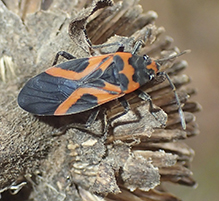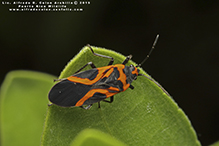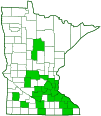false milkweed bug
(Lygaeus turcicus)
Conservation • Description • Habitat • Ecology • Distribution • Taxonomy
Conservation Status |
|
|||||||
| IUCN Red List | not listed |
|||||||
| NatureServe | not listed |
|||||||
| Minnesota | not listed |
|||||||
Description |
||
False milkweed bug is a medium-sized seed bug. It occurs in the United States east of the Great Plains, in Ontario Canada, and in Mexico. Adults are ¼″ to ½″ (6.5 to 13 mm) long, fairly hard-bodied, robust, and oval. The head is mostly black with a large. Y-shaped, orange mark extending from the top of the head (vertex) to in front of each compound eye. The beak-like part of the head containing the mouth parts (rostrum) has four segments. It is short, slender, and projects downward and forward when sucking plant juices. It is tucked into a groove on the underside of the thorax when not in use. The antennae are much longer than the head but much shorter than the body. They have four segments including the short basal segment (scape). They are not widened at the tip (clubbed). There are two large compound eyes on the sides of the head and two small simple eyes (ocelli) on the top of the head. The distance between an ocelli and the adjacent compound eye is about six times the distance between the two ocelli. The exoskeletal plate covering the thorax (pronotum) is about twice as wide at the rear than at the front. The front third is mostly black. The rear two-thirds is mostly orange with two broad black spots at the rear margin and two small spots at the front. There are two pairs of wings, and they are held flat over the body when at rest. The front wings (hemelytra) are longer than the hind wings and only slightly longer than the body. The exoskeletal plate between the wing bases (scutellum), is large, triangular and entirely black. The hemelytra have a thickened part at the base and a thin, membranous part at the tip, with a clear dividing line between the two. The thickened part is comprised of a narrow area (clavus) behind the scutellum when the wings are closed, and a broad marginal area (corium). The clavus is orange in front, black at the rear. The corium is mostly orange with a small black spot on the inner margin near the front and a large black spot on the outer margin near the middle. The combined black areas on the scutellum, clavus, and corium give the appearance of two overlapping heart-shaped spots in the middle and a large spot on each side. The membranous portion of the hemelytron has 4 or 5 veins. It is entirely black, without white spots and without a white margin. The legs are black. The last part of the leg (tarsus), corresponding to the foot, has 3 segments. The last tarsal segment has a claw at the tip and a pad at the base of each claw. |
||
Size |
||
Total length: ¼″ to ½″ (6.5 to 13 mm) |
||
Similar Species |
||
Large milkweed bug (Oncopeltus fasciatus) is larger. The pronotum is black with orange lateral margins. Each hemelytron has one forward-pointing and one backward-pointing orange triangle separated by a broad black band. The membranous portion of the hemelytra does not have white spots or edges. Small milkweed bug (Lygaeus kalmii) has a single, large, black, heart-shaped triangle on the back. The red mark on the top of the head is an unbranched line. |
||
Habitat |
||
|
||
Ecology |
||
Season |
||
|
||
Behavior |
||
|
||
Life Cycle |
||
|
||
Nymph Food |
||
|
||
Adult Food |
||
Seeds of false sunflower (Heliopsis helianthoides) |
||
Distribution |
||||
|
Sources |
|||
| 10/9/2022 | ||||
Occurrence |
||||
Common |
||||
Taxonomy |
|||
Order |
Hemiptera (True bugs, Hoppers, Aphids, and Allies) | ||
Suborder |
Heteroptera (True Bugs) | ||
Infraorder |
Pentatomomorpha | ||
Superfamily |
Lygaeoidea (seed bugs and allies) | ||
Family |
Lygaeidae (seed bugs) | ||
Subfamily |
Lygaeinae | ||
Genus |
Lygaeus | ||
Synonyms |
|||
Lygaeus trimaculatus |
|||
Common Names |
|||
false milkweed bug |
|||
Glossary
Clavus
On Hemiptera: The hard part of the forewing that is adjacent to the scutellum when the wings are closed. Plural: clavi.
Corium
The thickened basal portion of the front wing that lies between the clavus and the membrane of insects in the family Hemiptera. Plural: coria.
Hemelytron
The forewing of true bugs (order Hemiptera), thickened at the base and membranous at the tip. Plural: hemelytra.
Ocellus
Simple eye; an eye with a single lens. Plural: ocelli.
Pronotum
The exoskeletal plate on the upper side of the first segment of the thorax of an insect.
Rostrum
The stiff, beak-like projection of the carapace or prolongation of the head of an insect, crustacean, or cetacean.
Scape
In plants: An erect, leafless stalk growing from the rootstock and supporting a flower or a flower cluster. In insects: The basal segment of the antenna.
Scutellum
The exoskeletal plate covering the rearward (posterior) part of the middle segment of the thorax in some insects. In Coleoptera, Hemiptera, and Homoptera, the dorsal, often triangular plate behind the pronotum and between the bases of the front wings. In Diptera, the exoskeletal plate between the abdomen and the thorax.
Tarsus
On insects, the last two to five subdivisions of the leg, attached to the tibia; the foot. On spiders, the last segment of the leg. Plural: tarsi.
Visitor Photos |
|||||
Share your photo of this insect. |
|||||
| This button not working for you? Simply email us at info@MinnesotaSeasons.com. Attach one or more photos and, if you like, a caption. |
|||||
Babette Kis |
|||||
Lygaeus turcicus false milkweed bug Lygaeus turcicus, false milkweed bug, on asteraceae (formerly compositae) seedheads. Barnes Prairie, Racine Co., WI, photos were taken on November 9, 2021. These bugs added a bright note to a late autumn walk. |
 |
||||
Alfredo Colon |
|||||
 |
|||||
MinnesotaSeasons.com Photos |
|||||
|
|||||

Slideshows |
||

Visitor Videos |
|||
Share your video of this insect. |
|||
| This button not working for you? Simply email us at info@MinnesotaSeasons.com. Attach a video, a YouTube link, or a cloud storage link. |
|||
Other Videos |
|||
| False milkweed bug Bug of the Week |
|||
About
Jul 4, 2016 During the busy summer season false milkweed bugs combine dinner with a date in flower blossoms. |
|||


Created: 7/29/2020
Last Updated:


